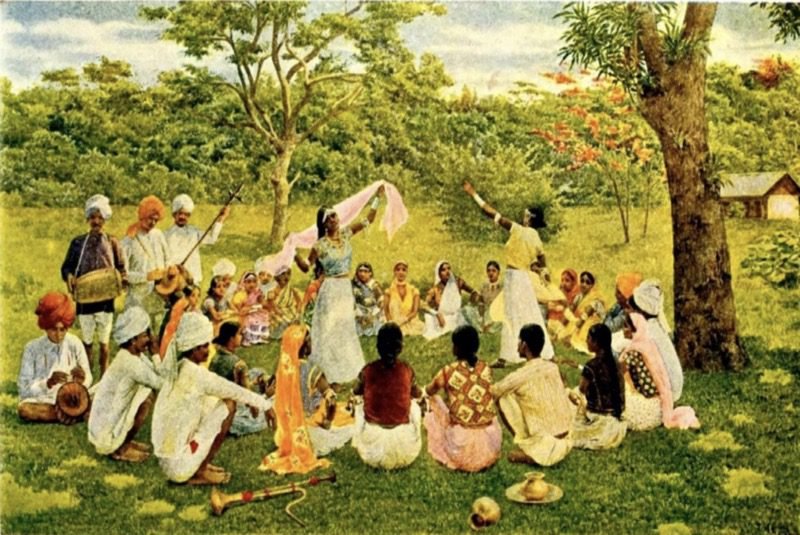Chutney Music: The Forgotten Fusion of Bhojpuri Folk and Caribbean Rhythms

Chutney music, an extraordinary fusion of Bhojpuri folk traditions and Caribbean influences, holds a unique place in the history of music. Originating from the indentured labor communities of Bihar and Uttar Pradesh, this genre traveled thousands of miles across oceans, transforming into a vibrant musical expression of the Indian diaspora in the Caribbean. Over time, however, its presence in India diminished, making it a rare and often overlooked form of cultural heritage. This blog delves into the origins, evolution, characteristics, and the present status of Chutney music, shedding light on its fascinating journey and cultural significance.
Origins of Chutney Music: The Roots in Bihar and Uttar Pradesh
The story of Chutney music begins in the 19th century when British colonial rule led to the forced migration of thousands of Indian laborers to the Caribbean, particularly to Trinidad and Tobago, Guyana, Suriname, and other parts of the West Indies. These indentured laborers, primarily from Bihar and Uttar Pradesh, carried with them their traditions, language, and music. Bhojpuri folk songs, devotional chants, and wedding melodies formed the core of their musical expressions, helping them stay connected to their homeland despite the harsh realities of plantation life.
These folk songs, often accompanied by simple instruments like the dholak, harmonium, and manjira, were deeply rooted in themes of love, longing, and devotion. Women played a crucial role in preserving these songs, passing them down through generations as oral traditions. As time progressed, the influence of their new Caribbean environment began shaping these melodies into a unique musical genre.
The Historical Roots of Chutney Music
To understand the origins of Chutney music, one must first look at indentured labor migration. During the colonial period, the British transported thousands of Indians—predominantly from Bihar and Uttar Pradesh—to the Caribbean to work on sugar plantations. These workers carried their Bhojpuri folk traditions, music, and instruments with them. However, over time, their music began to merge with the diverse cultural elements of their new homeland. The term “Chutney” itself reflects this fusion. Just as chutney in Indian cuisine blends different ingredients to create a flavorful mix, Chutney music represents a mixture of Bhojpuri melodies, Afro-Caribbean beats, soca rhythms, and even elements of reggae and calypso. It became a powerful form of cultural expression, helping the indentured laborers preserve their Indian identity while also adapting to their new environment.
Evolution and Key Figures of Chutney Music
The transition of Chutney music from its folk roots to a mainstream Caribbean phenomenon happened gradually. The 20th century saw a wave of artists modernizing the genre while keeping its Bhojpuri essence intact.
The Pioneers of Chutney Music
– Sundar Popo – Known as the Father of Chutney Music, Sundar Popo revolutionized the genre with songs like “Nana and Nani” and “Scorpion Gyul”, which blended Bhojpuri lyrics with soca beats.
– Drupatee Ramgoonai – The Queen of Chutney Soca, she introduced a more dynamic and bold approach to the genre.
– Rikki Jai – A modern Chutney Soca artist who brought global attention to the genre.
– Kanchan and Babla– Indian artists who helped bridge the gap between Chutney music and Bollywood.
The Transformation: Influence of Caribbean Sounds
The Caribbean, known for its diverse and rich musical heritage, exposed the Indian community to African and Creole rhythms, particularly calypso and soca. The fusion of these vibrant beats with Bhojpuri lyrics gave birth to what is now known as Chutney music. The dholak beats merged with the pulsating tempos of steel drums, guitars, and synthesizers, creating a lively and danceable sound.
One of the earliest pioneers of this fusion was Sundar Popo, a Trinidadian artist who is often credited with popularizing Chutney music on a global scale. His songs, such as Nani and Nana, combined humorous storytelling with rhythmic melodies, making them widely popular among Indo-Caribbean communities. As the genre evolved, artists like Drupatee Ramgoonai introduced Chutney Soca, blending even more elements of soca music into the traditional Chutney sound.
Characteristics of Chutney Music: A Unique Blend
Chutney music is characterized by its energetic beats, fast tempos, and the use of both Indian and Caribbean instruments. The lyrics, predominantly in Bhojpuri or Hindi, often explore themes of love, relationships, and social issues. Some common features of Chutney music include:
– Rhythmic Fusion: A combination of dholak, tassa drums, and electronic beats creates an infectious rhythm that encourages dancing.
– Call and Response Singing: This traditional style, found in both Indian and African music, enhances the interactive nature of Chutney performances.
– Use of Local Dialects: Many Chutney songs retain the Bhojpuri dialect, preserving linguistic elements that have faded in mainstream Indian music.
– Celebratory Themes: Weddings, festivals, and community gatherings often feature Chutney music as an essential part of the festivities.
Decline in India: Why Chutney Music Became Rare
Despite its deep-rooted connection to Bihar and Uttar Pradesh, Chutney music never gained mainstream recognition in India. Several factors contributed to its decline:
- Cultural Disconnect: As Bhojpuri folk traditions evolved in India, they took different musical directions, leaving Chutney music behind in favor of newer trends.
- Lack of Awareness: Unlike in the Caribbean, where Chutney music became a cultural symbol, in India, it remained largely unknown beyond regional communities.
- Western Influence on Indian Music: The rise of Bollywood and Western music genres overshadowed many traditional folk styles, including Chutney.
- Migration of Practitioners: With the descendants of indentured laborers settling permanently in the Caribbean, the transmission of this musical tradition within India faded over generations.
The Revival Efforts: Can Chutney Music Make a Comeback?
Though rare in India today, efforts are being made to revive interest in Chutney music. Bhojpuri film industries occasionally incorporate elements of Chutney in their soundtracks, and digital platforms have allowed Indian audiences to rediscover Indo-Caribbean artists. Social media and YouTube channels dedicated to Bhojpuri folk music also play a role in preserving and sharing old Chutney tracks.
Additionally, cultural festivals celebrating Indian diaspora traditions are fostering a renewed appreciation for Chutney music. The rise of Indo-Caribbean artists collaborating with Indian musicians offers a promising path for the genre’s revival. With globalization bridging gaps between cultures, there is potential for Chutney music to be reintroduced to Indian audiences in an innovative and contemporary format.
Why is it Known as Chutney Music?
Chutney music derives its name from the Indian condiment “chutney,” which is a flavorful blend of various ingredients, often spicy, tangy, and diverse in taste. The term “chutney” perfectly encapsulates the essence of this musical genre because it is a fusion of different cultural and musical influences, much like how chutney combines multiple ingredients to create a unique flavor.
The genre originated among the Indian indentured laborers in the Caribbean, particularly those from Bihar and Uttar Pradesh, who brought their Bhojpuri folk traditions with them. Over time, their music absorbed elements from the local Caribbean soundscape, including soca, calypso, and reggae, resulting in a rich and lively fusion. Just as chutney in food represents a mix of different spices, chutney music symbolizes the blending of Bhojpuri folk with Caribbean rhythms and instrumentation.
The naming of chutney music also reflects the improvisational and evolving nature of the genre. Like food chutney, which can be made with varying ingredients depending on regional tastes and preferences, chutney music has constantly adapted, incorporating new influences while retaining its core essence.
Furthermore, the name highlights the lively, energetic, and festive spirit of the music. Chutney music is known for its fast beats, danceable rhythms, and celebratory themes, much like how a good chutney enhances a meal with its zest and vibrancy. The metaphor of chutney, a staple in Indian cuisine, made the name an apt description for this cultural and musical blend.
In summary, the reason it is called chutney music lies in its fusion-based nature, its ever-evolving character, and its ability to mix diverse influences into a cohesive, flavorful whole—just like the culinary chutney that inspired its name.
Conclusion: The Legacy of Chutney Music
Chutney music stands as a testament to the resilience and adaptability of cultural traditions. Born out of displacement and struggle, it evolved into a joyous and expressive art form that continues to thrive in Caribbean communities. While its presence in India may have diminished, its legacy remains significant, serving as a cultural bridge between India and its diaspora. As efforts to revive folk traditions gain momentum, Chutney music has the potential to reclaim its space in the Indian musical landscape, ensuring that this unique fusion of Bhojpuri folk and Caribbean rhythms is never forgotten.


